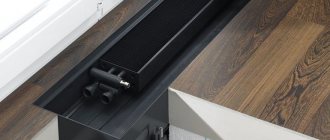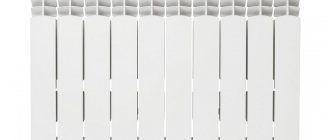Heating an apartment or private house is one of the key expenses for utility bills during the cold season. For this reason, people tend to choose the cheapest heating technology for their home. It's no secret that the most profitable fuel is natural gas. It has a high efficiency, is significantly cheaper compared to electricity, and is absolutely safe if all necessary rules are followed.
Recently, so-called gas convectors have become increasingly popular. Such heating equipment appeared on the shelves of domestic stores not too long ago, so not all people understand what features of the device they need to pay attention to when purchasing. We decided to help you solve this problem and developed a rating of the best gas convectors. Here we will talk in detail about the key operational characteristics of such devices, and also give a number of useful tips that will definitely help you when purchasing this heating equipment.
What does a gas convector consist of and how does it work?
A gas-powered convector is a ready-made mini-heating system.
If you need to heat one room, for example, a large hall in a country house, just install the device and connect it to a power source - a natural gas line or cylinders. There is no need to purchase a boiler, pipes, pump, or radiators separately. The operating principle is based on a change in the characteristics of the fuel as its temperature increases. The air flow passes through the heat exchanger, heats up and moves up to the ceiling. It is replaced by colder portions of air that follow the same path. This process is called convection, and the units themselves are called convectors.
Modern heating devices meet safety requirements, are efficient in operation, and in terms of their external design and control method are completely suitable for installation in a residential area.
The traditional and technically sound installation location is the section of the wall under the window: heat loss in this area is considered to be maximum.
The location of the convector is determined by the principle of its operation: the lower the device is installed, the more efficiently the air in the room will be heated
The design of a gas convector is a combination of the following components:
- Housing or casing that performs two functions: protective and decorative. This is a metal box coated with heat-resistant anti-corrosion paint, with holes for air circulation and fittings for installation.
- A gas burner is an element responsible for burning gas. It is interfaced with a heat exchanger and equipped with an igniter with an electrode, which is used to ignite.
- The heat exchanger performs the main function of heating the air. The larger its surface area, the more efficient the heating will be, which is why the ribbed configuration is common.
- Smoke exhaust system . The combustion products of gas heating units are removed in two ways: naturally or forcefully, using a built-in fan. In the first case, combustion is supported by air intake from the room, in the second - from the street, through a coaxial pipe.
- Valve that allows you to regulate the pressure of fuel entering the combustion chamber. Connected to the thermostat and responds to its signals.
- Thermostat . The combination valve is controlled by a thermostat, which can be adjusted to a comfortable temperature.
- The control system of modern models is automated. If an emergency situation occurs: a decrease in pressure, a shortage of combustion air, a fan failure, or a flame extinguishment, the convector stops working.
Heaters with tangential fans increase the rate of pumping heated air and warm up the room faster.
To increase the heating properties, the walls of the housings of expensive models are made thicker. The units function not only as convectors, but also as radiators - they transmit thermal radiation from heated metal to the surrounding space
All gas models are universal in relation to the type of fuel. They can operate on both natural and bottled gas. Requirements for combustible materials are set out in GOST 5542-2014 .
Principle of operation
A gas convector is an autonomous device for heating rooms, operating on the principle of natural convection of air masses. Cold air is at the bottom of the room, heating up, it rises until it begins to cool.
The heater operates as follows:
- a heat exchanger is placed inside the device, which is connected to convection channels;
- when gas is burned, it begins to heat up;
- air masses pass through the heating element and are warmed;
- the heated air enters the room.
Operating principle of a gas convector
Hosseven HP-3
The Hosseven HP-3 gas convector stands out from similar heaters with its unique design. Its body is strictly black, and the entire front panel is made of heat-resistant and impact-resistant glass, through which it is pleasant to observe the beautiful bluish flame. This convector is similar to a fireplace. The model is equipped with a closed combustion chamber, which has a positive effect on the quality of the air inside and on the efficiency of the device. The heat exchanger is made of steel with developed fins, which ensures the best heat transfer. The set temperature is maintained by a built-in thermostat. HP-3 is a stationary heater, “tied” to the installation site by a hole in the wall. Another thing is its versatility in terms of fuel type. By default, it runs on natural gas or can be easily converted to liquefied gas (cylinder). This makes installation in the country possible. The model under consideration has a heating power of 2.7 kW. There are more powerful analogues HP-5 (4.1 kW) and HP-8 (6.2 kW).
Main advantages:
- Great design;
- Fast heating;
- Safety.
Minuses:
- Price.
Models in the line:
- Hosseven HP-5
- 4.1 kW; - Hosseven HP-8
- 6.2 kW.
Installation
The fundamental document for installing heating equipment is the operating instructions included with the product. It provides a description and sequence of installation operations.
Peculiarities
- Wooden house. Thermal insulation of wooden structures is required. It will be necessary to make fire breaks to the roof. The surface of the coaxial chimney heats up slightly due to its design features; there is no need to insulate it.
- Distance from the floor. The minimum distance to the base is no less than 10-15cm. This is necessary for efficient supply of cooled air. Increasing the distance will lead to the formation of a lower cold layer, increasing the temperature under the ceiling.
- Location along the walls. It is limited to the point of external supply of the main pipe for a natural fuel convector and the outlet of the coaxial chimney. The use of a balloon option adds freedom to choose the installation location. It is necessary to take into account the location of people and the location of barriers to heat flow in the form of furniture.
- Connection. Gas pipe laying, wiring and connections are carried out by accredited gas service specialists. The connection to the steel pipe is made with a flexible hose.
- Commissioning activities. The presence of representatives of the local gas service is required. Based on the test results, a note is made in the accompanying documentation for the gas converter.
A gas convector for heating a private house or garage is a successful design for temporary residence of people. An additional function is backup heating equipment.
Timberk TGH 4200 M1
- Characteristics
- Average price: 5,890 rub.
- Country: China
- Power: 4.2 kW
- Heating area: 20 – 60 sq. m.
- Gas consumption: 0.31 kg/hour
- Heat exchanger: no
- Chimney diameter: no
- Ignition: piezo
Timberk TGH 4200 M1 has a strict classic design and mobile design. Powered by bottled gas. The heater has three power levels and is suitable for heating rooms with an area of 20 to 60 sq.m. According to customer reviews, the device heats up quickly and heats economically: the bottle lasts for about 50 hours of continuous operation at maximum power. The convector is equipped with a fuse for insufficient oxygen levels in the air, and in the absence of a flame, the gas supply automatically stops, which makes the model safe to use. But for some reason the manufacturer did not take care of the shutdown button - you can turn off the convector only by turning off the gas.
Karma BETA 2 Comfort 02
If necessary, this device can be easily integrated into a smart home system.
The design includes an electronic thermostat, thanks to which the temperature is maintained with an accuracy of one tenth of a degree. The creators tried to give this device maximum resemblance to a real fireplace. In particular, they equipped it with a window made of heat-resistant glass through which the flames can be observed. The power of the device is only 2 kW, however, this indicator is quite enough for high-quality heating of a room up to 40 square meters. m. The convector is very technologically advanced, equipped with a GSM module. Through it, up to three similar devices can be connected to one thermostat. The design does not have an igniter, which makes it possible to reduce the amount of fuel consumed by approximately 30% when comparing the products with standard mechanical devices.
Advantages:
- Low consumption of natural gas;
- Stylish appearance;
- High quality assembly and workmanship;
- Able to fit into any interior of the room;
- Long period of operation.
Flaws:
- A power of 2 kW is not enough for all consumers.
Termotechnik AKOG-4
This device is ideal for a garage or country house.
The design is distinguished by the most accurate factory settings and compact overall dimensions. It is very easy to install, and it practically does not require any additional wiring. Such a convector is often installed even in industrial or industrial premises, the area of which does not exceed 40 square meters. m. The heater is absolutely independent of water and gas supply, since, if necessary, it can be connected to an ordinary gas cylinder - this is quite convenient, because centralized gas is not found everywhere. Combustion products will not penetrate into the room, which makes the device absolutely safe. Maintains the set temperature independently. The device's gas consumption is low, and the convector itself can last for quite a long time.
Advantages:
- It is a completely autonomous heating device;
- Lightweight and very compact device;
- Low fuel consumption;
- Operational safety.
Flaws:
- Some users feel that the control buttons are not very convenient;
- The convector is sensitive to changes in gas pressure.
ATEM Zhytomyr-5 KNS-4
- Nomination: High operational safety
The model is equipped with a flame sensor, non-volatile Italian automation and a sealed combustion chamber, which makes it absolutely safe for use in any room. - Characteristics
- Average price: 17,500 rub.
- Country Ukraine
- Power: 4 kW
- Heating area: 40 sq. m.
- Gas consumption: 0.42 cubic meters m/hour
- Heat exchanger: steel
- Chimney diameter: no information
- Ignition: piezo
ATEM is a well-known company specializing in heating equipment. Its devices are leaders in the CIS markets in terms of production volumes, and the Zhitomir line is one of the most purchased, because it combines a low price and excellent technical characteristics. These convectors are one of the most reliable and safe ones running on natural gas. The combustion chamber is hermetically enclosed in a housing, so harmful substances do not enter the heated room. The device is equipped with Italian automatic equipment with a gas valve 630 Eurosit, the non-volatile mechanism of which does not require connection to the network. Another safety benefit is the flame sensor. It instantly shuts off the gas if the flame goes out.
Residential installation
A gas convector for home heating is safe if the operating rules are followed. The danger comes from the working fluid – natural or liquefied gas. Hence a number of restrictions on installation and operation:
- Convectors with an open combustion type are allowed to be installed in private buildings. Installation in multi-storey buildings is prohibited. It is allowed to use the system in an apartment without an external chimney.
- Structures with any type of combustion are allowed for use in low-rise private housing construction.
- It is allowed to use thermal appliances in industrial and civil premises.
- Preparation of documents for the installation of a separate gas convector is simpler than for a water heating boiler.
In any case, the use of equipment requires approval from the gas service of the locality.
FEG Konvektor GF 35 P
Equipped with a heat exchanger, which is made from special high-strength steel, which is pre-heat treated. This element is manufactured using a unique patented technology, which ensures instant heat transfer to the environment. The device will not overheat or shut down even under the most severe operating conditions.
It runs on natural gas and is almost silent - no clicks or crackles were detected. If necessary, the device can be converted to propane or butane in cylinders. The design is characterized by increased power, but the external design is a bit disappointing - many consumers find the convector unsightly.
Advantages:
- Capable of running on propane and butane from cylinders;
- Operates absolutely silently;
- Adapted to harsh Russian working conditions.
Flaws:
- Not very stylish case design.
Hosseven HP-8
It is characterized by a very high efficiency, which for this convector is 90%.
This quality ensures minimal heat loss and accelerated heating of the room. The product has a unique design that transfers heat directly into the air rather than onto the coolant. The temperature range is from 13 to 38 degrees. The device has a very accurate thermostat. It comes complete with a special adapter for connecting to cylinders, so the device is often purchased by residents of non-gas supply areas and owners of country houses. There is a chamber installed here that ensures a closed combustion cycle; there is a coaxial chimney, so all exhaust gases will go outside. The design has compact overall dimensions and a stylish appearance.
Advantages:
- The dimensions of the case allow the heater to be installed even in a small room;
- There is everything you need for comfortable use;
- Very high efficiency;
- Chamber with a closed fuel combustion cycle.
Flaws:
- Quite expensive.
Alpine Air NGS-20F
Alpine Air NGS-20F is a gas convector with wall mounting, equipped with a reliable and durable (rated for 50 years) cast iron heat exchanger. Other features of the device are non-volatile automation and reliable operation even at extremely low temperatures. In a particular model, only the operation of the built-in fan, used for faster heat distribution, depends on the electrical network. The Alpine Air NGS-20F uses a closed combustion chamber. A telescopic coaxial pipe is included in the kit to allow air to flow in and combustion products to be removed outside. The convector uses a gas burner and fittings made in Italy. The heater in different configurations can be connected to network (natural) gas or bottled (liquefied) gas. When purchasing, it is better to clarify the configuration option for a specific instance or obtain information about the availability of an additional kit. The Alpine Air line of gas convectors includes models NGS-20, 30, 40, 50 (2, 3, 4, 5 kW) and analogues with the addition of a fan (indicated by the letter F).
Main advantages:
- Cast iron heat exchanger;
- Reliability;
- Fan.
Minuses:
- Requires a hole in the wall.
Models in the line:
- Alpine Air NGS-30F
- 3 kW, thermal ventilation (convectors); - Alpine Air NGS-40F
- 4 kW, thermal ventilation (convectors); - Alpine Air NGS-50F
- 4.9 kW, thermal ventilation (convectors); - Alpine Air NGS-20
- 2.2 kW; - Alpine Air NGS-30
- 3 kW; - Alpine Air NGS-40
- 4 kW; - Alpine Air NGS-50
- 4.9 kW.
Video description
Video instructions for measuring gas flow with a convector:
- Cast iron. Sufficiently heat-intensive - able to retain heat for a long time after being turned off. Disadvantages: fragility, heavy weight.
- Duralumin. Strong, lightweight, durable. The downside is that it is quite expensive.
- Copper. Durable, plastic, not subject to destruction. The disadvantage is the very high cost.
A convector with a cast iron heating circuit is most optimal for domestic use. It is durable and retains heat for a long time. However, during installation and operation it is necessary to take into account its increased fragility.
Automation
Convector gas heating from bottled gas can be controlled either by a simple automation system based on a relay and thermostat, or by a more advanced software module that sets many operating parameters. The final cost of the device largely depends on the type of automatic unit used. However, the more factors are taken into account in the settings, the more economical the consumption will be and the more comfortable the living conditions will be.
The best mobile gas heaters for home and garden
Bartolini Pullover K
The Bartolini Pullover K gas heater can be used for efficient heating of various types of premises: houses and apartments, cottages, outbuildings and garages. It can become the main or additional (or backup) heat source. The device is mobile - it moves easily on wheels. The heating element of the device is a catalytic panel. It is made of fiberglass, and platinum powder acts as a catalyst. Thanks to the use of this technology, there are no harmful emissions and no odor in the room during operation of the heater. The fuel for the device is liquefied propane-butane. The design of the housing is such that the gas cylinder (27 or 24.5 l) is placed inside and covered with a casing. The heater is equipped with safety elements:
- Burner flame level control sensor;
- Rollover protection (automatic shutdown when tilted);
- Air condition monitoring sensor (shutdown when carbon dioxide concentration is exceeded).
Additional features:
- Piezo ignition;
- Power regulator.
Main advantages:
- Reliability;
- Quiet operation;
- Manufacturer: Italy.
Minuses:
- Large dimensions.
Models in the line:
- Bartolini Pullover K Turbo Plus
- has 3 positions (turbo mode, hot air, cold air), heated area 45 - 50 sq. m.
Timberk TGN 4200 SM1
Timberk TGN 4200 SM1 ceramic gas heater is an inexpensive, mobile and universal device. Its mobility is ensured by its compact body and wheelbase for easy movement. The capabilities of the device allow it to be successfully used for heating premises of various types and purposes. The heater operates from a propane-butane cylinder (up to 12 liters, regular or 12.5 liters composite), which is easily placed inside a metal casing. For connection, the kit includes a reducer, gas hose and clamps. The room is heated by infrared radiation generated when ceramic plates are heated by a gas burner. Such material ensures complete combustion of fuel, and, therefore, the air does not contain combustion products. For safe operation, the model is equipped with gas control and a CO2 concentration monitoring sensor. Additionally, rollover protection is provided. Piezo ignition and power regulator are used as control elements.
Main advantages:
- Affordable price;
- Mobility;
- Versatility.
Minuses:
- Periodic ventilation of the room is necessary.
How to choose a good gas heater?
We will conditionally divide gas heaters into three types - portable, portable and stationary . We will divide according to the type of power supply - a compact gas cylinder (threaded or collet) for portable models, connection with a hose to the main line, gas holder or cylinder for portable ones (naturally, the design and weight itself must imply the ability to be carried), a natural gas main line or a cylinder for stationary ones, either too heavy to carry, or purely physically mounted somewhere.
Portable gas heaters , so beloved by fishermen, hunters and tourists, should be assessed by the reliability of installation (especially on uneven surfaces) and the quality of gas heating, both of these parameters being closely related. After all, a heater that has fallen on its side may also begin to spit out an open flame if the liquid phase entering it from the cylinder when it is turned over does not evaporate - and this, you understand, is unsafe. If the heater has the ability to be used as a hotplate, you have a bingo: with such a device you can both warm up and boil tea, and on larger models you can even fully cook food. However, keep in mind that versatility has a downside - a regular camping stove will boil water faster... but it won’t warm it either.
Portable gas heaters are more of a “dacha-garage” option. Their power is higher, and, therefore, the efficiency will already be noticeable in terms of gas costs - simple models with a metal mesh should be put aside, preferring “ceramics”, which will provide the same level of “infrared power” at lower gas costs and with a better resource . The main thing is not to forget that any infrared heater, including a gas one, heats the surfaces it is directed at, not the air - therefore, it is stupid to compare the power of infrared heaters with heat guns, which are much more effective for heating (but are also more voracious, and oxygen they “eat” only on the way). But the most important thing is that it is extremely desirable to cut off the gas when the flame goes out or overturns: you understand, no one will constantly monitor the heater at home and especially in the garage, and it is not difficult to accidentally touch it in the same garage. Saving on security is such a thing.
If we take a stationary heater , then first of all its thermal power is important, of course - it would be stupid to spend money on the heater itself, and then spend time and effort on installing it, only to discover that it doesn’t really warm up the room. Shutting off the gas when the burner goes out is mandatory here, and automatic re-ignition is desirable: however, “purely mechanical” models also have their advantages, which are less convenient to use, but can work in the most remote village, where even a cardiologist can read the oscillogram of the voltage in the socket will grab his head.
Floor or wall installation
According to the installation method, all convectors are divided into:
- floor;
- wall-mounted
Floor-standing ones are distinguished by greater power and heat transfer, so they are installed in spacious rooms - workshops, garages, warehouses. To ensure that heavy units remain stable, a strong and level base is prepared before installation.
Wall-mounted units are household convectors suitable for living rooms, halls, and halls. They take up minimal space, as they are attached directly to the wall, through which the chimney exits.
The traditional installation location is under a window or near a door. A warm curtain prevents the entry of cold air through cracks in window or door openings, creating a cozy microclimate in the house
To reduce the load on the wall, the heat exchanger in modern budget models is made of steel rather than cast iron.
The cost of floor-standing and wall-mounted gas convectors is almost the same; to a greater extent it depends not on the type at the installation site, but on the technical characteristics and materials from which the main parts are made.
Selecting the power of the device
The comfort of those living in a heated room depends on the correct choice of power. On average, approximately 1 kW is required for a volume of 30 m³. Devices with power from 2 kW to 12 kW are intended for domestic use.
There is a large assortment of heating devices with a power of 2-6 kW with a steel heat exchanger on the market. They are attractive with their design and low price, but their service life and efficiency are lower than their analogues with a cast iron heat exchanger.
Considering the likelihood of ventilation, drafts, and insufficient insulation, you need to take a unit with a small power reserve. Let’s assume that a 40 m³ room requires a 2 kW convector.
Flaws
All of the above belongs to the category of advantages of gas convectors. Next we will look at the shortcomings. All pros and cons are such only in the context of this article. For example, if we take the speed of acceleration of a car, then high engine power can be considered a plus, and driver safety and fuel efficiency can be considered a minus.
This is the case with gas convectors. The biggest disadvantage of this device is that you need to drill into the wall to install it. And not just make a hole, but a hole for a coaxial gas outlet. The gas outlet is a special tube in a pipe through which exhaust gases exit, and the fresh air necessary for combustion enters the convector through an external pipe. It is logical to assume that there should be a hole in the wall in the place where the convector is located, and if they are located under every window in every room, imagine how many holes there will be in your house! And these holes cannot be hidden or brought to one place. And remember another hole in the wall for gas supply. A vivid picture of a house appears before your eyes, shrouded in gas pipes and full of holes in the walls. Agree, not a very inspiring sight!
Let's imagine a living room with an area of 30 square meters with two windows. Using a standard heating system, a convector would need to be placed under each window. In the case of gas convectors, this option does not work. We will need to install one convector with increased power in a certain place on the external wall of the room, where there would be optimal conditions for supplying gas there and making a duct for exhaust gases. With this installation there will be no temperature balance in the room. It will be hot in one corner and cold in the opposite. For comfort, you need to place another low-power convector under each window, which immediately doubles the cost of the entire system and the aesthetics of the room. We conclude that this option is inferior to a conventional water heating system.
The gas convector has low inertia. In other words, it heats up very quickly and cools down at the same speed, which can be considered both a plus and a minus, it all depends on how the device is used. In a residential area, of course, this negatively affects the comfort of the temperature regime, but for a garage, workshop or shed, quick heating is a definite plus.
There is one more nuance in a gas convector, which can, in a certain case, be considered a plus or a minus. It has a combustion chamber in which the gas, burning, heats a certain body and a chamber, which then heats the air. For a long service life of the convector, it must use steel that is resistant to fading. It’s good if it uses just such a special steel. But in this case it will not be cheap at all. If it uses cheap steel, then the convector will very quickly fail due to corrosion, burnout, etc. Now, if in a convector the combustion chamber is made of 10 mm cast iron, then such a device will practically last forever.
Pros and cons of gas convection heating
The production of heating appliances is developing due to the demand for gas equipment.
Among the main advantages noted by users are the following:
- Economic benefit . The purchase and installation of a gas unit is more expensive than its electric counterpart, but subsequently you will have to pay much less for fuel consumption. Especially if the source is natural gas.
- Versatility . Gas appliances are designed to connect both natural and bottled gas. The ability to run on propane will come in handy for owners whose homes are not supplied with mains fuel.
- Lack of coolant . There is no need to install a pipeline, and in winter, during downtime, there is no risk of liquid freezing. Local convection heating is convenient for garages and small cottages.
- Environmental friendliness . Devices with a coaxial pipe and a closed combustion chamber do not burn oxygen from living spaces.
But there are also some disadvantages. For example, not everyone likes the dimensions of heating devices - more compact electric analogues can be found on sale. For residential premises, it is preferable to buy wall-mounted models that take up less usable space.
If a room in the house is not thermally insulated enough and has several windows or doors to adjacent rooms, it is difficult to provide full heating - there will also be cold areas
The steel heat exchanger, typical of inexpensive models, cools quickly, thereby reducing heating efficiency.
Features of use
The operating principle of the device is based on the physical phenomenon of convection. Streams of cold air penetrate through the lower grilles, heat up from the heat exchanger and rise to the ceiling. Constantly circulating air quickly heats the room. When installing convectors, there is no need to install heating pipes in the apartment.
Several convectors are installed in a large house. A main gas pipeline must be connected to each of them. One device heats a room with a volume of up to 130 cubic meters. It maintains a given temperature regime with a minimum gas flow rate - from 0.22 to 0.48 m3/hour, depending on the model.
The efficiency of the devices reaches 88%. In comparison, gas boilers operate with efficiency of up to 98%. The performance is improved for devices with fans, but at the same time the noise level in the room increases. When heating and cooling, steel convectors emit a characteristic crackling sound (the metal expands or contracts). Cast iron casings do not produce any sounds.
Gas appliances come in two types: wall-mounted and floor-mounted, fireplace type. They are fastened in the same way, have a common principle of operation, but the latter are larger in size.
How to install a gas convector
After you have chosen and purchased the heater, you can proceed to preparing the installation. Make sure you have the following tools and materials:
Tools necessary for installing a gas convector.
When everything is ready, you need to choose the location of the convector. For the correct selection, use GOST. The latter requires mandatory installation of the heater under the window. Don’t be lazy in the process to try on the device to the chosen place, and also make markings after that. The next stage is preparing the premises. The room must be covered, as during work a large amount of dust will appear.
Installation
Technical requirements for installation of a gas convector.
Installation is carried out according to the following plan:
Gas connection
Take this stage extremely seriously. If you doubt your skills, it is better to entrust the connection to specialists.
Carry out installation according to the following scheme:
In accordance with GOST, the pipe must be installed from the street.
Functionality check
Before turning on the device, be sure to call the gas service to check the connections for gas leaks.
After completing the installation work, you need to do a test run:
Sources
- https://sovet-ingenera.com/otoplenie/radiator-obogrev/otopitelnyy-gazovyy-konvektor.html
- https://www.expertcen.ru/article/ratings/luchshie-gazovye-obogrevateli.html
- https://markakachestva.ru/rating-of/5402-luchshie-gazovye-konvektory-rejting.html
- https://zen-Top.ru/top-luchshih-gazovyh-konvektorov/
- https://delta-instrument.ru/pechi-i-obogrevateli/gazovyj-konvektor-na-ballonnom-gaze-otzyvy.html
Precautionary measures
The use of household appliances requires compliance with safety precautions. Be careful and listen to the advice of manufacturers:
- You cannot use a convector that has a damaged viewing window,
- if the device goes out spontaneously, do not re-ignite it earlier than after 3 minutes,
- To prevent burns, the convector is protected with a protective grille.
It is strictly prohibited:
- dry things on a running appliance,
- turn the device on and off for children and people with limited legal capacity,
- operate the device with the outer casing removed,
- repair the device yourself,
- place flammable objects at a distance of less than 1 m from it,
- leave it on if signs of a gas leak are detected.
If there is an unpleasant odor in your home, take immediate precautions:
- turn off the gas supply,
- extinguish all sources of open fire,
- do not touch switches and mobile phones,
- ventilate the room
- urgently call the emergency gas service,
- Contact a gas convector service center.










